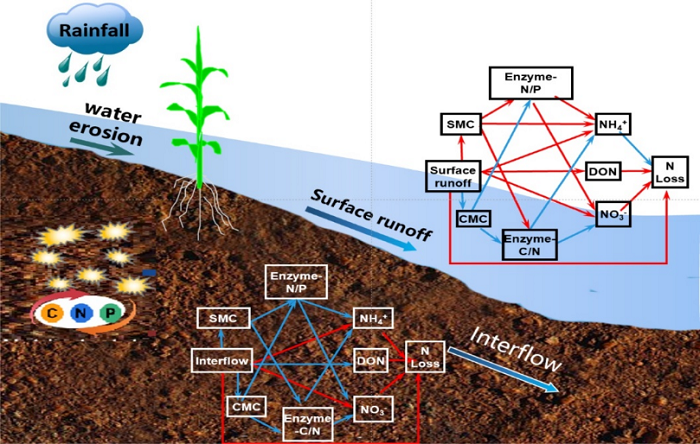Recently, the Innovation Team for Agricultural Clean Watershed at the Institute of Environment and Sustainable Development in Agriculture, CAAS, took a deep dive into the effects of soil colloids and extracellular enzymes on soil nitrogen loss in hydrological paths, and revealed the differential co-transport mechanisms of soil colloids and extracellular enzymes in surface runoff and subsurface flow during nitrogen loss in sloping farmland. The related findings were published in Geoderma, a leading international journal of soil science.
Extracellular enzymes and soil colloids play an important role in nitrogen transformation and migration. The study confirmed that co-transport phenomenon exists between extracellular enzymes and soil colloids during hydrological processes, and this co-transport process significantly affects nitrogen loss. In surface runoff, the migration of extracellular enzymes is primarily influenced by fine particle colloids, while in subsurface flow, it results from the combined effects of both coarse and fine particle colloids. The significant differences in soil colloid concentration and extracellular enzyme activity lead to differential responses of nitrogen load in surface runoff and subsurface flow. The co-transport process of soil colloids and extracellular enzymes significantly affects nitrogen loss, explaining 95% and 55% of the differences in nitrogen loss paths in surface runoff and subsurface flow, respectively.

This study explored the co-transport mechanisms of soil colloids and extracellular enzymes in nitrogen loss through different hydrological paths after erosive rainfall. It systematically assessed the influence mechanism of the stoichiometric characteristics of soil colloids and enzymes on soil nitrogen transfer process in different hydrological paths, providing new insights into the micro-mechanisms of soil nitrogen loss from eroded slopes and the prevention and control of non-point source pollution.
This study was funded by the National Natural Science Foundation of China (41977072) and the National Key R&D Program of China (SQ2023YFD1900062).
Linkage: https://doi.org/10.1016/j.geoderma.2024.117041

